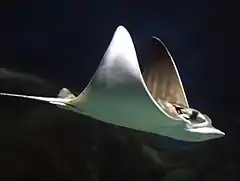| Aetomylaeus | |||
| Garman, 1908[1] | |||
 A. bovinus | |||
| Systematyka | |||
| Domena | |||
|---|---|---|---|
| Królestwo | |||
| Typ | |||
| Podtyp | |||
| Gromada | |||
| Podgromada | |||
| Infragromada | |||
| (bez rangi) | płaszczki | ||
| Nadrząd | |||
| Rodzina | |||
| Rodzaj |
Aetomylaeus | ||
| Typ nomenklatoryczny | |||
|
Myliobatus maculatus Gray, 1834 | |||
| Synonimy | |||
| |||
| Gatunki | |||
| |||
Aetomylaeus – rodzaj ryb chrzęstnoszkieletowych z rodziny orleniowatych (Myliobatidae).
Rozmieszczenie geograficzne
Do rodzaju należą gatunki występujące w wodach oceanów – Atlantyckiego, Indyjskiego i Spokojnego[4][5].
Morfologia
Długość ciała do 240 cm; masa ciała (największa opublikowana) 116 kg[5].
Systematyka
Rodzaj zdefiniował w 1908 roku amerykański ichtiolog i herpetolog Samuel Garman w artykule poświęconym spodoustym i chimerom opublikowanym w czasopiśmie Bulletin of the Museum of Comparative Zoology at Harvard College[1]. Gatunkiem typowym jest (oryginalne oznaczenie) A. maculatus.
Etymologia
- Myliobatis: gr. μυλη mulē ‘młyn, żarna’; βατoς batos lub βατις batis ‘płaska ryba, zwykle stosowana w odniesieniu do płaszczki lub rai’[6]. Gatunek typowy (późniejsze oznaczenie): Myliobatis bovina Geoffroy St. Hilaire, 1817[4].
- Aetomylaeus: zbitka wyrazowa nazw rodzajów: Aetobatus Blainville, 1816 (Aetobatidae) i Myliobatis Cuvier, 1816; łac. przyrostek -eus ‘odnoszący się do’[6].
- Pteromylaeus: gr. πτερον pteron ‘skrzydło, wiosło’; rodzaj Aetomylaeus Garman, 1908[3][7]. Gatunek typowy (późniejsze oznaczenie): Myliobatis asperrimus Gilbert, 1898[8].
Podział systematyczny
Do rodzaju należą następujące występujące współcześnie gatunki[4]:
- Aetomylaeus asperrimus (Gilbert, 1898)
- Aetomylaeus bovinus (Geoffroy St. Hilaire, 1817) – orleń afrykański[9]
- Aetomylaeus caeruleofasciatus White, Last & Baje, 2015
- Aetomylaeus maculatus (Gray, 1834)
- Aetomylaeus milvus (Valenciennes, 1841)
- Aetomylaeus niehofii (Bloch & Schneider, 1801)
- Aetomylaeus vespertilio Bleeker, 1852)
- Aetomylaeus wafickii Jabado, Ebert & Al Dhaheri, 2022
Opisano również gatunki wymarłe:
Uwagi
Przypisy
- 1 2 S. Garman. New Plagiostomia and Chismopnea. „Bulletin of the Museum of Comparative Zoology at Harvard College”. 51 (9), s. 252, 1908. (ang.).
- ↑ É. Geoffroy Saint-Hilaire: Poissons du Nil, de la mer Rouge et de la Méditerranée. W: Description de l’Egypte ou recueil des observations et des recherches qui ont été faites en Égypte pendant l’expedition de l’Armée français, publié par les ordres de sa Majesté-L’Empereur Napoléon le Grand. Cz. 1: Histoire Naturelle. Paris: Imprimerie Impériale, 1817, s. ryc. 26. (fr.).
- 1 2 S. Garman. The Plagiostomia (sharks, skates, and rays). „Memoirs of the Museum of Comparative Zoölogy, at Harvard College”. 36, s. 437, 1913. (ang.).
- 1 2 3 Ron Fricke, William Neil Eschmeyer, Richard Van der Laan (red.), SEARCH, [w:] Eschmeyer's Catalog of Fishes, California Academy of Sciences, 2 kwietnia 2024 [dostęp 2024-04-20] (ang.).
- 1 2 R. Froese & D. Pauly: Aetomylaeus. FishBase (ver. (02/2024)). [dostęp 2024-04-20]. (ang.).
- 1 2 Ch. Scharpf: Family Myliobatidae Bonaparte 1835 (Eagle Rays). The ETYFish Project. [dostęp 2024-04-20]. (ang.).
- ↑ E.C. Jaeger: Source-book of biological names and terms. Wyd. 3 (Revised second printing). Springfield: Charles C. Thomas, 1959, s. 211. (ang.).
- ↑ D.S. Jordan: The genera of fishes. Cz. 4: From 1881 to 1920, thirty-nine years, with the accepted type of each. A contribution to the stability of scientific nomenclature. Stanford: Leland Stanford Jr. University Publications, 1906, s. 548, seria: Leland Stanford Jr. University Publications, University Series Nr 43. (ang.).
- ↑ Josef Reichholf, Gunter Steinbach, Claus Militz: Wielka encyklopedia ryb : słodkowodne i morskie ryby Europy. Wiśniewolski Wiesław (tłum.). Warszawa: Muza, 1994. ISBN 83-7079-317-7.
- ↑ Pollerspöck i Straube 2023 ↓, s. cojimarensis.
- ↑ Pollerspöck i Straube 2023 ↓, s. cubensis.
- ↑ Pollerspöck i Straube 2023 ↓, s. dixoni.
Bibliografia
- J. Pollerspöck & N. Straube: Bibliography Database of living/fossil sharks, rays and chimaeras (Chondrichthyes: Elasmobranchii, Holocephali). shark.refrences.com, 2023. [dostęp 2024-04-16]. (ang.).
This article is issued from Wikipedia. The text is licensed under Creative Commons - Attribution - Sharealike. Additional terms may apply for the media files.